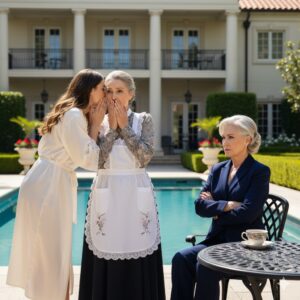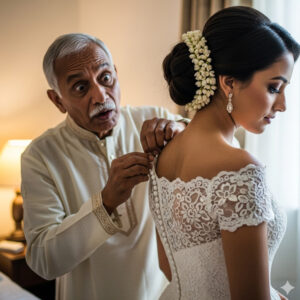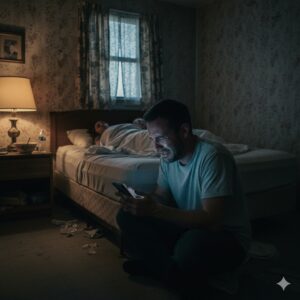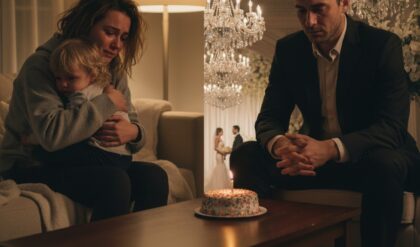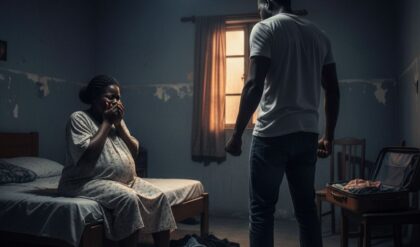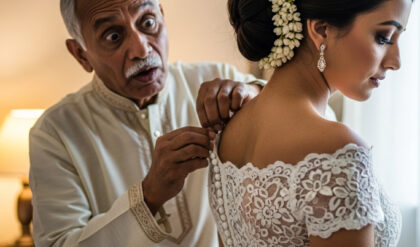“My boyfriend left me because I have vitiligo… now he’s asking for another chance.”
Marcos’s words echoed in my head like a cruel sympathy: “I’m sorry, Elena, but this vitiligo thing… I can’t deal with this. People are staring at us, whispering. It’s not what I expected.”
I stood there, in the doorway of my apartment, watching the man with whom I had planned a future walk away. My hands trembled as I unconsciously touched the white spots that decorated my face and arms, the ones that had appeared three years ago and that had now, apparently, cost me my relationship.
For weeks, I locked myself in the house. Mirrors became silent enemies I avoided at all costs. But one afternoon, while cleaning the attic, I found my old camera and the albums from when I dreamed of being a model.
“What would have happened if I had kept trying?” I wondered.
It was my sister Carmen who pulled me out of the hole. She arrived one Saturday morning with coffee and unwavering determination.
“Elena, look at yourself. You are beautiful. You always have been, but now you are unique. Do you know how many people would kill to have something that makes them stand out in a world full of identical faces?”
Her words were like seeds planted in fertile soil. That same afternoon, I looked in the mirror for the first time in months—really looked at myself. The white patches on my brown skin created unique patterns, like personalized constellations. For the first time, I didn’t see flaws. I saw art.
I started taking photos of myself, first timidly, then more daringly. I posted some on my social media with the hashtag #VitiligoBeauty. The response was overwhelming: hundreds of people sharing their own stories, thanking me for my courage.
Modeling agent Sarah Mitchell contacted me three months later. She had seen my photos on Instagram.
“Elena, we need authentic, real models who represent true diversity. Your beauty is powerful because it’s honest.”
My first shoot was for an inclusive beauty product campaign. I was nervous, but when I saw the final photos, I couldn’t hold back the tears. For the first time, I looked beautiful, completely beautiful.
The jobs started pouring in. Fashion magazines, advertising campaigns, runways. My face appeared on billboards in New York with the slogan: “Beauty doesn’t come in just one color.”
Two years later, my name was on the covers of Vogue, Harper’s Bazaar, and Elle. I became a global ambassador for organizations supporting people with vitiligo and other skin conditions. I gave lectures on self-esteem and diversity.
The media called me “The Constellation Model” because of my unique skin patterns. There were runway shows dedicated exclusively to models with vitiligo, and I was the main focus.
One day, while I was signing autographs after a fashion show in Paris, my assistant handed me my phone….
“You have a call. He says it’s important.”
It was Marcos.
“Elena… I’ve been seeing you everywhere. Magazines, TV… you look amazing. I… made a mistake. A big mistake.”
His voice sounded different, smaller. But I was no longer the same woman he’d left.
“Marcos,” I said with a calmness that surprised me, “when you left me, I thought my world had ended. I believed the spots on my skin made me less worthy of love.”
I paused, looking at my reflection in the dressing room mirror, where my makeup artist had deliberately highlighted every white spot for the show.
“But you were wrong, and I was wrong too. These spots aren’t flaws. They’re my signature. They’re what makes me unique in a world full of conventional beauty.”
“Elena, please give me another chance. I’ve changed. Now I understand…”
“No, Marcos. You haven’t changed because you’ve seen me in magazines. You’ve changed because the world now considers me successful. But I was already valuable when you left me. The problem was, neither of us knew it.”
I hung up the phone and smiled. In a few hours, I’d be on the main stage of Milan Fashion Week, closing the most important show of my career.
As I walked toward the runway, I thought of that scared Elena hiding from mirrors. Now, every camera flash illuminated my “spots” as if they were diamonds embedded in my skin.
Vitiligo hadn’t ruined my beauty; it had redefined it.
And Marcos was right about one thing: I looked incredible. Not because I was famous, but because I had finally learned to see myself through my own eyes, not through those of those who couldn’t appreciate the work of art I already was.
At the end of the runway, as the audience stood in applause, I gently touched the spots on my neck and whispered, “Thank you for teaching me that real beauty doesn’t hide. It shines.”
News
The girl who lost her parents at the age of 6 suddenly “changed her life” and became the daughter-in-law of a wealthy family with just one trick with the maid in the house. She thought she had everything in her hands, but unexpectedly, a truth made her lose everything./hi
At just six years old, Maya Cooper lost both her parents in a car accident. She grew up in foster homes, bouncing from family to family, learning early that in this world, survival meant being sharp — and silent. By…
Her Husband Threw Her and Their Son Out in the Rain — His Mistress Gave the Wife $500 and Whispered, “Come Back in Three Days… You’ll See Something Unexpected.”/hi
It was raining hard that evening in Seattle, the kind of cold, relentless drizzle that seeps into your bones.Grace Miller stood outside her own house — the home she had built with ten years of love, patience, and sacrifice —…
The husband looked down on his sloppy wife. “Your place is in the corner of the house.” He didn’t let her go to the party with him. When he got to the party, he was shocked to see her there./hi
“You should stay home tonight. The wedding’s high-end, full of executives and business partners. If you come, it’ll just… embarrass me.” That’s what Mark Wilson said as he adjusted his tie, refusing to look his wife in the eye. His…
At 61, I remarried my first love: On our wedding night, as I took off her dress, I was shocked and heartbroken to see…/hi
My name is Rajiv, and I’m 61 years old. My first wife passed away eight years ago after a long illness. Since then, I have lived alone, in silence. My children are already married and settled. Once a month they…
Knowing that his boss “took notice” of his wife, the husband was willing to “give his wife” to his boss in exchange for the position of deputy director. He thought everything was going smoothly, but 3 months later, an email sent to him put him in a miserable situation./hi
The night Ryan Miller was promoted to Vice President of Operations, he couldn’t stop smiling.He toasted every coworker, bragging about “hard work paying off,” while one person sat quietly at home — his wife, Claire. She stared blankly at the…
The wife said she would go home to take care of her sick mother. In the middle of the night, her husband checked his GPS and found her in a hotel room. He rushed there and was shocked by the scene before his eyes./hi
She Said She Was Visiting Her Sick Mother — But When He Checked Her Location at Midnight, It Showed a Hotel. When He Rushed There, What He Saw Froze Him to the Core. That Friday night after dinner, Lisa packed…
End of content
No more pages to load
